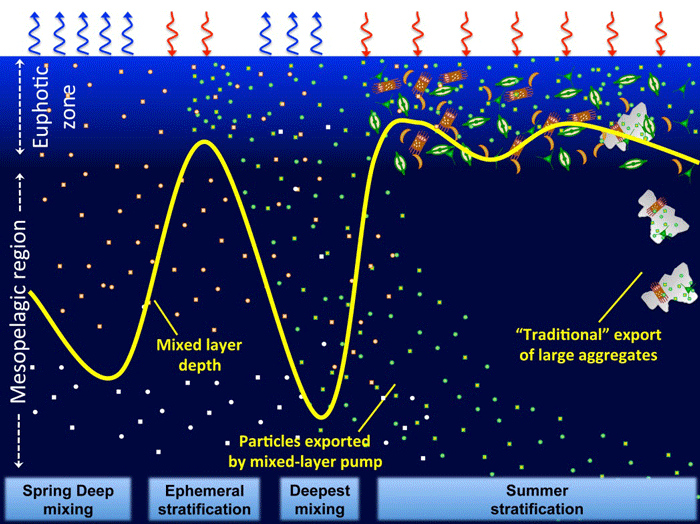Combining satellites and Argo-floats, scientists at NCEO-Plymouth Marine Laboratory have estimated the energy sources supporting life in the deep, dark ocean. The research was published today in Nature Geoscience.
The part of the ocean between 100 m and 1000 m is called the mesopelagic region. This region contains one of the largest ecosystems on the planet and most of the ocean’s fish. Yet the mesopelagic remains a vastly unexplored and poorly understood ecosystem. Basic questions such as what energy fuels the mesopelagic ecosystem remain only partially answered.
Up to now this ecosystem has been thought to be sustained by a ‘rain’ of fast-sinking organic aggregates of dead plankton and waste products from surface-living organisms – the so-called biological carbon pump. Whilst this source of organic carbon is very important, marine scientists have come to realize that it simply is not sufficient to support the vast numbers and variety of organisms that live in the mesopelagic layer, and have investigated another oceanographic mechanism – the seasonal mixed-layer pump.
This pump takes non-sinking particles as well as dissolved organic carbon from surface waters into the depths, and thus supplies an additional pulse of organic carbon to the mesopelagic. During spring-time stormy conditions, strong winds mix surface water and the organic carbon it contains deep into the ocean. This deeply-mixed carbon is then ‘trapped’ inside the mesopelagic region when the shallow summer mixed layer forms and becomes available as an energy source to mesopelagic organisms. Overall, these variations in the surface mixed layer could thus pump part of the missing carbon into the mesopelagic, but there has never been a concerted effort to estimate the total flux of organic carbon that they supply across the world ocean.

Schematic demonstrating how seasonal variations in mixed-layer depth can pump organic particles from the surface to the mesopelagic ecosystem.
Now Plymouth Marine Laboratory (PML) scientists, funded via NCEO and working with colleagues from France, have estimated this amount. By combining satellite data from the European Space Agency Ocean Colour-Climate Change Initiative with in-situ measurements obtained by Argo and new Bio-Argo floats, partially-funded by the UK Natural Environment Research Council, they estimate that the pump moves around 300 million tons of carbon each year. In the deeply-mixed high-latitude regions, the figure represents an average of 23%, but possibly in excess of 100% of the better studied flux of faster-sinking, larger particles and aggregates.
Dr Giorgio Dall’Olmo, from PML, who led the research, says: “Most methods for measuring carbon transport into the deep ocean have concentrated on the particles that sink at relatively fast rates, but have not measured how neutrally-buoyant or slowly-sinking organic particles are redistributed through the water column. This means that current global estimates of carbon export in the ocean are missing the potentially important contribution from the seasonal mixed-layer pump. Our new global estimates should thus be considered as an additional flux of organic carbon to the mesopelagic region that was previously not accounted for, and that’s important when we try to understand which sources of energy fuel the mesopelagic ecosystem.”
Link to paper in Nature GeoScience by Dall’Olmo et al.